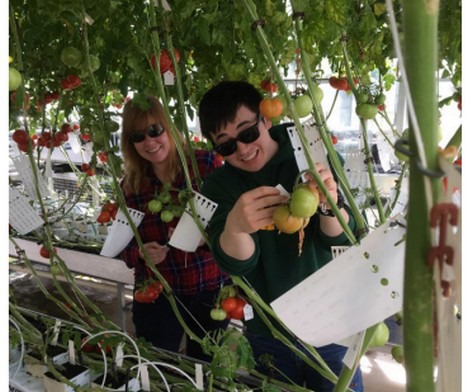Using genetic mapping and metabolomics analysis, Vineland and collaborators at Laval University, Quebec, Canada the University of Florida, USA and McMaster University, Ontario, Canada have identified the gene responsible for producing several important aroma chemicals, including the familiar tomato vine aroma associated with fresh tomatoes.
“Tomatoes like many other plants, carry nitrogen-containing volatiles derived mainly from the amino acids leucine and phenylalanine which were assumed to provide the nitrogen atom for these volatiles,” says David Liscombe, PhD, Vineland’s Research Scientist, Biochemistry and lead researcher for this project. “However, in our research, we found tomatoes produce nitrogenous volatiles in a unique way compared to other species – using cysteine as a source of nitrogen.”

Vineland team members Christine Kempthorne, PhD Candidate, Biochemistry and Kevin Hooton, Senior Research Technician, Biochemistry
Cysteine is an amino acid present in all organisms, and in plants, it plays a central role in converting sulfur from the environment into other amino acids and vitamins as well as flavor and defense-related chemicals.
“Well-known for its contribution to sulfurous chemicals like the pungent flavors in onion and garlic, we were surprised to find that cysteine is required to make all nitrogen-containing flavor volatiles in tomatoes, even those that do not contain sulfur,” explains Liscombe.
“This is a very different way to make these chemicals compared to other plants.” Vineland can now incorporate this important knowledge into its tomato breeding program to meet consumer preference for flavorful tomatoes.
 Vineland Research
Vineland ResearchDavid Liscombe, PhD
Research Scientist, Biochemistry
905-562-0320 x826
david.liscombe@vinelandresearch.com
info@vinelandresearch.com
www.vinelandresearch.com
